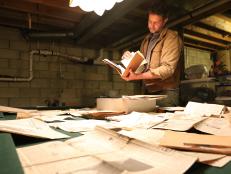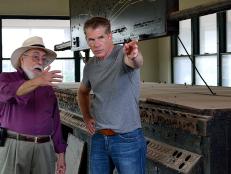Behind the Scenes: Top Moments From 'Mission Declassified'
Take another look at some of the greatest mysteries and troubling cases host Christof Putzel investigated on the show.

Related To:

Searching for Answers "That Don't Want to Be Found"
Investigative journalist Christof Putzel has wowed us time and time again on Mission Declassified by discovering clues hidden in newly declassified documents. If you still haven’t watched the show, it’s guaranteed to be your new favorite. Putzel uncovers new evidence from some of America’s biggest criminal cases. Here’s another look and a behind-the-scenes peek at some of our favorite mysteries explored on the show.
Studying a Killer
In the episode “The Axeman of New Orleans,” Putzel headed down to the infamous French Quarter to investigate one of the most gruesome crime cases in American history. Between 1917 and 1919, New Orleans had a serial killer targeting Sicilian immigrants. The killer was ruthless, murdering victims in their sleep with an ax. Considered one of the deadliest killing sprees of the century, the case still hasn’t been solved; but new information in declassified documents could finally help close this case.
Testing a New Theory
One of the pieces to this mystery that’s stumped police for decades is how the Axeman broke into so many homes undetected. Putzel uncovered an old newspaper article where police said that in every victim’s home, the lower panel of a door had been removed. At the time, police believed the killer would reach through this opening and unlock the slide-lock to get into the home so Putzel put this theory to the test. He met with master woodworker Sean Wilkerson at Bank Architectural Antiques and cut through an old antique door. The two learned that while you can’t reach the slide-lock, you can squeeze through the opening if you’re small enough.
Digging Through Archives
After examining newly released documents, Putzel found a witness statement from a woman claiming she saw not one but two Axemen. On a tip that the killings might have been the work of an organized crime group instead of a crazed killer, Putzel traveled to the island of Palermo to examine some of the oldest records of the Italian mafia.
Searching for a Link
At the state archives in Palermo, Putzel met with Vittorio Coco, a historian and expert of organized crime, to review the first official police report to recognize the mafia as a criminal organization in the late 1800s. In this document, Putzel uncovered a link between the names of the Axemen victims in New Orleans and the family names of those in the earliest recorded mob groups.
Revisiting the Past
In the episode “Decoding America’s UFO Secrets,” Putzel investigated some of the strangest claims in history regarding alien ships and things that just can’t be explained such as the red lights US military personnel saw outside the Royal Air Force Bentwaters base in Suffolk, England in 1980. The case is infamous as many believe it to be a cover-up by the US and UK government. Putzel went to the UK to meet with retired Col. Charles Halt, to discuss what he saw years ago at the former US airbase. The colonel revealed tape recordings that are sure to give you goosebumps.
Looking for Clues
Putzel also investigated another incident the US government deemed unexplainable. The mysterious sighting happened in 1967 in Falcon Lake, Canada. A prospector named Stefan Michalak claimed he saw two cigar-shaped flying objects and, when he got too close to one of the crafts, he was severely burned by the exhaust. Photos of Michalak’s burns show a strange grid pattern too perfect to be made by chance.
Gearing Up
Today, the site where Michalak was burned and supposedly witnessed a UFO sighting is inside Falcon Beach Ranch. Putzel headed to the Manitoba homestead and met with ranch owner Devin Imrie.
Braving the Elements
Imrie agreed to take Putzel to the exact location where Michalak’s encounter took place, but the episode was shot during the winter so the crew had to ride snowmobiles through the tough, snowy terrain.
Testing New Evidence
After seeing the site of Michalak’s encounter firsthand, Putzel traveled to Winnipeg, Canada to meet with Michalak’s son Stan Michalak. He gave Putzel a piece of metal that his father found at the sight that night. Using new technology at the University of Manitoba, Putzel worked with scientists to test the components of the metal and learned that the piece was high in uranium--something not common in industrial metal.
Painting a Personality
In the episode “The Black Dahlia Murder,” Putzel investigated one of the most infamous, unsolved murder cases in American history. In 1947, the body of 22-year-old Elizabeth Short was found in LA--cut in half. Putzel met with criminal psychologist Dr. Robert Schug to review crime scene photos never published in newspapers to determine what type of person could have done something so sinister and shocking.
Searching for a Match
After looking through crime scene photos and reviewing the suspect list, Dr. Schug speculated that the killer wasn’t crazy in a torn-from-reality kind of way, but that this would have been someone who could blend into society without being detected. Given that Smart’s body was found completely drained of blood, Schug suggested Putzel look into the case file of suspect Leslie Dillon who was a mortician’s assistant at the time and knew how to drain blood.
Scouring Records
The LAPD still has all files sealed regarding the Black Dahlia, but Putzel got his hands on files from the LA District Attorney’s office and a recently released document from the FBI regarding Elizabeth Short’s last-seen whereabouts.
Uncovering Missing Pieces
Putzel went to the LA city archives to look into Leslie Dillon’s history. There, he met with retired police sergeant Buz Williams. Williams spoke about how his father investigated the case all those years ago and that he was sure the killer was Dillon.
Learning Forensics 101
In a shocking twist, Putzel found a new lead that suggested Elizabeth Short may have been at a different location before her death than what police originally thought. Instead, newly released witness reports point to the Astor Motel--which is still standing in LA today. Putzel met with Theron Vine of Pure Gold Forensics to learn how to collect blood samples before investigating the motel off camera.
More From Travel
- The Discovery Family of Networks
- © 2024 Warner Bros. Discovery, Inc. or its subsidiaries and affiliates. All rights reserved.


